A step-by-step guide to pruning grapes in summer for beginner growers
Pruning is an important part of grape care. Not only the appearance of the plant depends on it, but also the quality of the crop. If you do not prune in the summer, nutrients will be directed to the growth of new shoots, and the berries will turn out to be tasteless and small.
The content of the article
Why prune grapes in summer
Summer pruning is also called green, as it is intended to remove young shoots, inflorescences, brushes and leaves.
This preventive treatment helps the berries ripen and strengthens the vine. In central Russia, getting a good harvest without summer pruning will not work.
Pruning goals
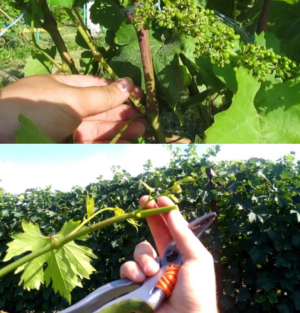
The main purposes of pruning in summer:
- Creating a balance between sterile and fruitful weaves. If there are too many sterile shoots on the vine, they will take up the nutrients needed to form fruit. If only fruiting branches remain, the crop will be small and tasteless.
- Ripening of large bunches.
- Acceleration of berry ripening. Moisture and nutrients reach the buds faster.
- Airing the bush.
- Simplification of care.
- Improving the vine.
After pruning, the plant tolerates frost and disease more easily.
Terms of the procedure
Pruning directly related to the stages of plant development: vegetation, flowering, formation and ripening of berries. They depend on the climatic conditions and the growing region.
Terms of the procedure:
- at the end of May - pinching of fruitful shoots and removal of young shoots;
- in July - pinching;
- in August - chasing and clarification.
Grape pruning schemes
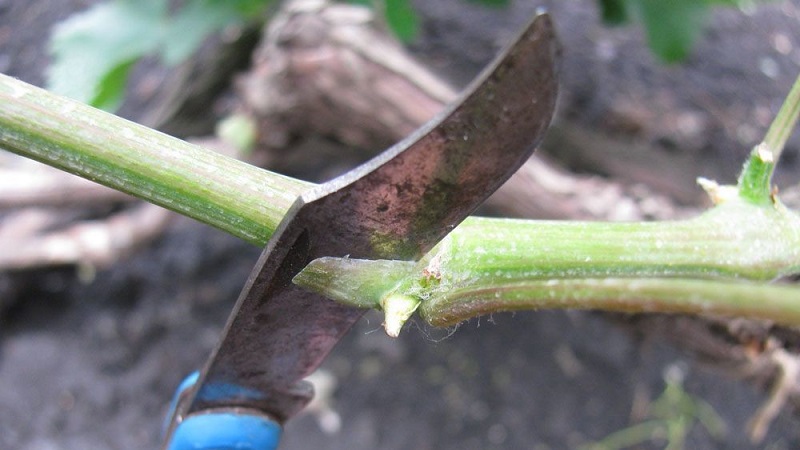
The vine is formed within the first 3-4 years. This is required for better ventilation.
The standard-free pruning option is suitable for regions with a cool climate, where grapes are sheltered for the winter. At the same time, they try to get a limited number of sleeves that diverge in 2 directions.
How to trim:
- First 2 years. During this time, up to 4 shoots approximately 1 m long are formed. They are examined, the 2 strongest are selected and cut into 3 eyes. The rest of the branches are deleted completely.
- Third year. Choose 3-4 developed shoots that diverge in different directions. They are cut to 50 cm and tied at an angle to the trellis.
- Fourth year. Cut the vine at the level of the offset knot. As a result, 4 fruiting vines should remain, which annually bring up to 18 brushes.
Punching allows you to increase the yield by about 40%. Thanks to this scheme, large clusters ripen, plant care is simplified. The method is suitable only for tall varieties.
Procedure:
- Near the vineyard, a 1.5 m long stake is dug in. Developing shoots are fixed to it.
- When the length of the central stem reaches 60 cm, the top of the second is pinched.
- The next year, the main shoot is cut off at the level of the trunk, and everything else is completely removed.
- Prune the vine, leaving only 2 eyes, remove other branches.
- As the shoots grow, the tops are pinched.
By the third year, stepchildren are formed, from which a fruit vine emerges.
The main stages of pruning
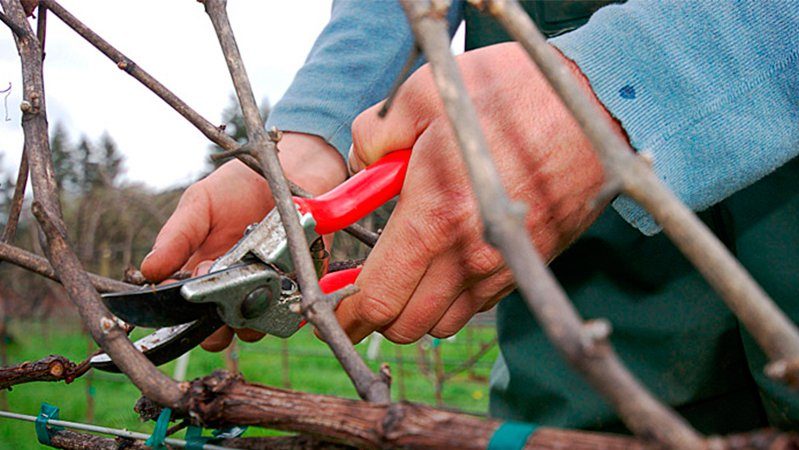
Removal of stepchildren is carried out immediately after flowering. If this is not done, the bush will become too overgrown, and the berries will become small and sour.
For pinching, take a thin branch and press on it with your thumb - it will easily break. At the very base, the stepson is not broken off, otherwise a new escape will soon appear from that place. It is enough to pinch off 1.5–2 cm. This procedure is repeated every week.
Pinching refers to cutting off the growing point of a branch to stop it growing. The main purpose of such an operation is to stimulate the formation of bunches.
To do this, pinch off the upper part of the lashes by about 3 cm. This redirects nutrients to the inflorescences. If you do not follow this procedure, the flowers will receive insufficient nutrition, which will lead to shedding. Pinching is especially important for varieties with loose clusters. The operation is performed every 2 weeks.
Minting is carried out at the end of summer... The procedure is very similar to pinching, but differs in that up to 40 cm of the shoot is removed. As a result, 15 productive leaves should remain on the cut branch.
Important! The minting accelerates the ripening of the fruit. It is especially important to perform it for late vigorous varieties. Without this stage, the harvest simply will not have time to ripen. For early varieties, the procedure is optional.
Clarification, or removal of foliage, is done when the berries are already poured. The main objectives of the procedure:
- lightening the vine so that the bunches receive more sunlight;
- prevention of gray rot and other diseases;
- improved ventilation of the bushes.
On each shoot, remove 5-10 old and yellowed, covering the clusters from the light and the leaves growing from the bottom of the bush.
The tendrils of grapes are modified shoots, so they also take away some of the nutrients from the brushes. This impairs overall generative development. The mustache is trimmed throughout the summer. Having stepped back from the branch 1-2 cm, they are removed with fingers or secateurs. If you plan to form a vine along some kind of fastening, the uppermost mustache is left, and the rest are cut off.
How to properly carry out summer pruning of grapes
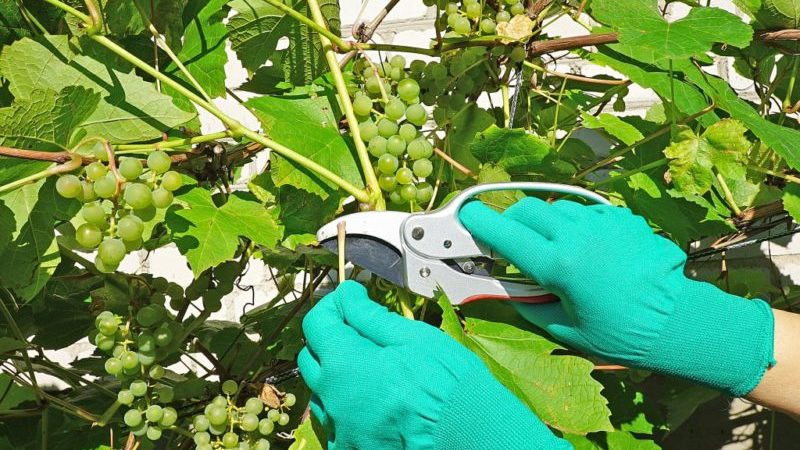
If you do not control the grapes by pruning, excess shoots will overgrow, taking away strength and nutrients from the fruit.
All procedures are usually performed manually, without the use of tools. However, some growers use a pruner or a sharp knife after disinfecting them.
Step-by-step instruction
Depending on the phase of plant development, the following pruning stages are distinguished:
- After the first buds bloom, it becomes clear which branches will not bear fruit. They are immediately removed along with weak shoots.
- In mid-June, the branches on which the bunches have appeared are pinched. Shoots are cut slightly above the top bunch.
- Only 1-2 clusters are left on each branch.
- After flowering, pinching is carried out throughout the summer. New branches are removed at the stage of their formation.
- In early August, minting is performed. Select unnecessary branches and cut them in half. Fruiting shoots are shortened by 40 cm.
- 15 days before ripening, most of the foliage is harvested, especially the one that blocks the bunches from the sun.
Mistakes to Avoid
In summer, it is difficult to harm the plant, but some gardeners feel sorry for removing fruiting shoots.
Consequences of incorrect cropping:
- Insufficient removal of the upper parts of the branches leads to a rapid build-up of green mass, which has a negative effect on the quality and quantity of the crop.
- Early minting leads to the fact that useful substances will not be used for ripening berries, but for the formation of new branches. It is performed only after inhibition of the growth of the bush.
- Excessive brightening can damage the bushes. Only the leaves that shade the fruit are removed.
Completing the pruning steps on time will rejuvenate the plant and prepare it for winter.
The nuances of pruning young and old grapes
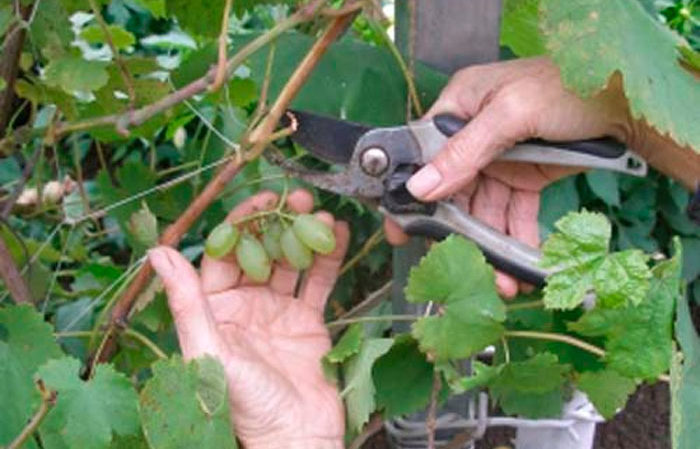
The timing and methods of summer pruning for grapes of different ages are similar. The only difference is with an autumn haircut, after the foliage has fallen.
Unviable branches are removed from old bushes.To determine them, it is enough to cut off a small part: if the cut is green, then the shoot is alive.
For different growing regions
The only difference is in the removal of foliage. In cool conditions of the middle lane, clarification is carried out regularly, and in the southern regions only plants are thinned out, on which fruit ripening is delayed.
Caring for grapes after pruning
Removing green shoots practically does not damage the plant, so the care remains standard:
- watering 2 times a month at the rate of 1 bucket of water per plant;
- regular loosening and mulching of the root space;
- feeding with ammonium sulfate and ammonium nitrate;
- tying the vine to the support.
Be sure to regularly inspect plants for diseases and pests. Young shoots are removed by hand, but so that damage is minimal.
Tips from experienced winegrowers
Summer pruning is considered preventive and formative.
In order not to harm the bush, it is better to adhere to these recommendations:
- carry out each stage in its own time, otherwise they will not make sense;
- due to a possible decrease in the protective functions of the vine after pruning, treat grapes with fungicides to prevent diseases;
- when gray rot occurs, spray the bushes with potassium permanganate, and the bunches - with a solution of baking soda;
- after hail or hurricane, cut off all damaged branches.
It is interesting:
Why do you need pruning grapes in the fall and how to carry it out correctly
Conclusion
Summer pruning is an important procedure for maintaining the health of the grapes and increasing yields. It is performed in several stages: in June, the non-fruiting branches are removed and the fruiting ones are pinched, in August they are minted, and throughout the summer - pinching.
It is important after the procedures to properly care for the crop, regularly watering and feeding it.